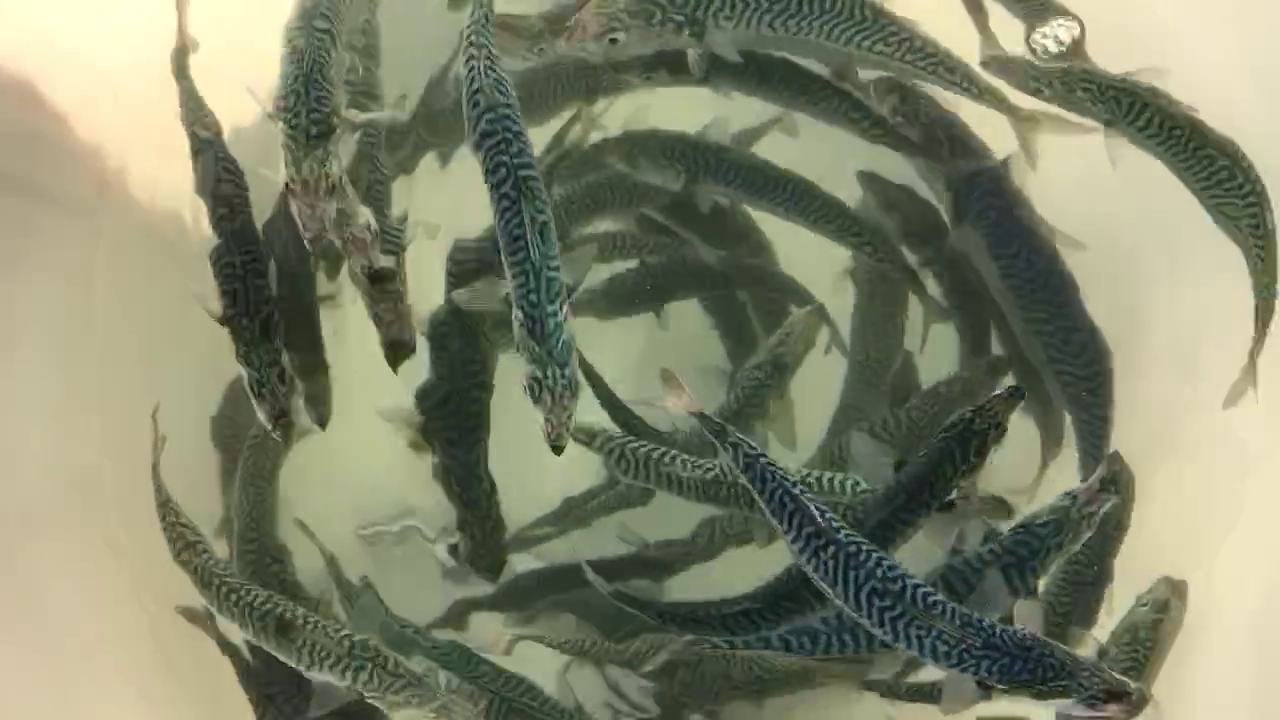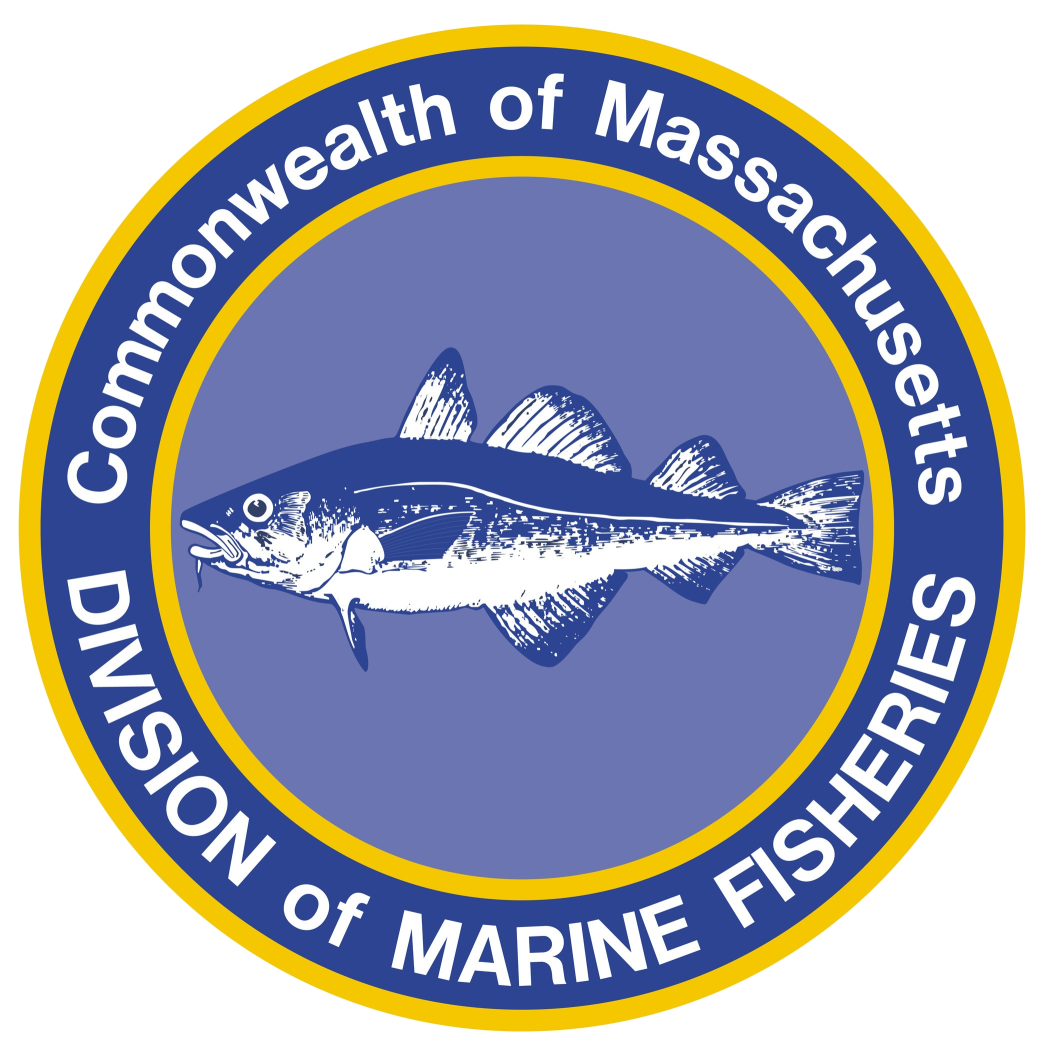- Division of Marine Fisheries

Description: The Atlantic mackerel, Scomber scombrus, is a handsome pelagic forage fish that is fished both commercially and recreationally in Massachusetts. The mackerel’s elongate body is an iridescent steel blue to green with distinct wavy black bars on the dorsal surface and a silvery-white underside. The deeply forked tail indicates that they are fast swimmers, and without a swim bladder, mackerel must keep swimming to survive.
Atlantic mackerel grow quickly, reaching sexual maturity by age 3 or at about 12 inches fork length. They can live up to 18 years but only grow to a little over 16 inches. In recent years, it has been uncommon to find fish over 7 years of age (~14 inches). Mackerel are opportunistic feeders and tend to form large tightly packed schools when feeding on plankton. Copepods are a primary prey, specifically lipid rich Calanus finmarchicus, which is also a favorite of the North Atlantic right whale. Mackerel will also eat small fish, shrimp, and squid.
This valuable migratory species is harvested commercially using mid-water trawls, purse seines, and jigs. Commercial landings in 2020 totaled more than 17 million lbs valued at approximately $5 million (NOAA Fisheries). The commercial fishery operates between January and May in southern New England and the Mid-Atlantic, and between May and December in the Gulf of Maine.
Mackerel are also highly important to recreational fisheries in the Mid-Atlantic and New England. They have become a favored bait for striped bass and highly migratory species fishing such as tuna. Many recreational fishers catch mackerel by jigging for them or using a “sabiki rig” with multiple small hooks coming off a main line decorated to resemble schooling minnows once the rig submerges. Along the coast, recreational catches are highest in state waters, particularly in Massachusetts, Maine, and New Hampshire where the catch totaled 4 million lbs in 2020 (NOAA Fisheries). In Massachusetts, recreational catch typically peaks in May and June but continues through the end of the year; few mackerel are caught recreationally prior to April.
Distribution: Atlantic mackerel are found on both sides of the Atlantic. Their distribution in the western Atlantic ranges from Newfoundland, Canada to Cape Hatteras, North Carolina. Two spawning contingents are recognized for this population: the southern contingent spawns in April and May in U.S. waters and the northern contingent spawns in June and July in the Gulf of St. Lawrence. Pelagic eggs are released through batches spawning several times throughout the season.
Atlantic mackerel are sensitive to changes in water temperature. Seasonal and interannual fluctuations in their migration patterns make their availability to fisheries highly variable and can complicate population tracking. Generally, mackerel move north and closer inshore in the spring and summer which is when they become accessible to the recreational fishery. In fall and winter, they move out to warmer waters on the continental shelf. In winter, the two spawning contingents mix.
Status: Northwest Atlantic mackerel have supported valuable fisheries since the 17th century. However, landings at present are near all-time lows and stock biomass has been in decline since the 1970s.
A combined U.S./Canada Atlantic mackerel egg index informs the stock assessment, along with biomass and abundance information from the NOAA Northeast Fishery Science Center bottom trawl survey. The egg index, developed from ichthyoplankton and mackerel egg surveys that span the distribution of the resource, show that egg production in the western North Atlantic has dropped by over 90% from the 1980s to 2010s. A northeastward shift in mackerel eggs and contraction of where larvae are found are also evident, with larvae occurring in Massachusetts waters but no longer in the mid-Atlantic region as was prevalent in the 1970s.
Large recruitment events have driven periodic increases in the mackerel stock. The last large year class was 1999. Aside from a somewhat moderate 2015 year class, all recent year classes have been weak. This pattern of low recruitment hinders the population’s ability to recover as does age truncation within the stock. Fish aged 7 years and older comprised about half of the stock in the 1980s but are now rarely observed. Recent assessments in 2018 and 2021 have indicated that Atlantic mackerel stock status is overfished with overfishing occurring. A rebuilding plan was implemented in 2019, however the 2021 stock assessment found that the stock was still less than a quarter rebuilt despite an 180% increase in stock size.
Fisheries Management: Atlantic mackerel are managed in federal waters along the east coast under the Atlantic Mackerel, Squid, and Butterfish Fishery Management Plan, with the Mid-Atlantic Fishery Management Council acting as the lead management body. The directed commercial fishery operates under an annual commercial allocation subject to weekly quota monitoring. Commercial activity is permitted under a limited access program (three tiers) based on past participation in the fishery and an open access permit for incidental catches. Presently, there are no federal or state recreational management measures for Atlantic mackerel. In 2021, an emergency closure capped the commercial catch. The 2022 commercial fishery is operating under an interim rule with a commercial catch limit of 4,963 mt (10.9 mill lbs).
In June, the Mid-Atlantic Council approved a revised rebuilding plan for Atlantic mackerel and fishery specifications for 2023. Compared to the original rebuilding plan, the revised plan uses lower predicted recruitment in projections to reduce the chance of underperforming stock growth predictions again. The Council’s selected fishery specifications for 2023 under the rebuilding plan include a much-reduced commercial quota and the implementation of the first-ever federal waters recreational possession limit of 20 fish. DMF is working collaboratively with the states of Maine and New Hampshire to have compatible management measures in state waters next year. The next mackerel assessment is expected in 2023 and will be used to evaluate progress toward rebuilding and to support development of fishery specifications for 2024.
By Kelly Whitmore, Fishery Policy Analyst
